Traditional Music and Instruments of the Mongolia poeple
Percussion instruments, though, were only played in connection with Shamanism and Buddhism, the origins of which can be found in Tibetan Lamaism, as well as with the "Tsam dance", which was performed in Mongolia for the first time in the 8th century.
| - Hel khuur (Jew's harp) Nowadays, a Jew's harp is made of brass or steel, but in earlier days it was made of wood or bamboo. A spring, acting as a vibrator, is fitted into a horseshoe-shaped metal holder and is called ,tongue'. The player places the long part of the instrument close to his mouth, touching it with his front teeth and manipulating the tongue with his right hand. Changing the shape of the mouth cavity, which at the same time acts as a resonance chamber, can vary the pitch. 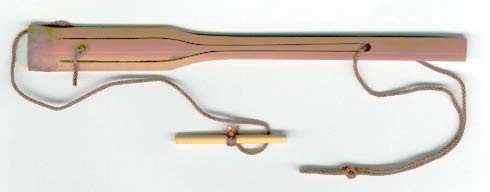 bamboo / wood jews harp bamboo / wood jews harp | |||||||||||||||||||||||
| - Tsuur (wind instrument) The tsuur is a traditional Mongolian wind instrument (flute) made of uliangar wood (bur chervil - umbellifer). Melody and sound resemble the sound of the waterfall of the River Jeven. The "aman tsuur" made by the Altai-Uriankhai tribes are the most popular ones and produce the best sound. | |||||||||||||||||||||||
| - Limbe (wind instrument) The instrument is frequently used in accompaniment, occasionally also as a solo instrument. In former times it was made of bamboo or wood, nowadays mostly of plastic, particularly those imported from China. These flutes (transverse flutes) are closely bound up with the nomads of Central Asia. The length of this instrument is approx. 64 cm, with nine holes, whereof one is the blowhole and two others are reserved for the tuning. It is often played with circular breathing*. The sound reflects what is heard in the nature or the sounds of the natural and social environment. - *Circular breathing (bituu amisgal): one note is blown while the musician inhales through his nose. The air is collected inside the cheeks and exhaled by the pressure of the cheeks' muscles (same principle as for the bagpipe). The base of the tongue is used as a valve. | |||||||||||||||||||||||
| - Surnai - ever buree (wind instrument) Reed instrument - a folk oboe with a conical body made of wood or horn (ever buree = horn), widening towards the end. It has seven finger holes and one thumbhole. A metal staple carries the reed and a lip-disc in the shape of a funnel. The short form of the instrument is known as "haidi", meaning 'flute of the sea'. | |||||||||||||||||||||||
| - Lavai - tsagaan buree (wind instrument) "Tsagaan buree" - white shells. White shells with whorls leading from the left to the right handside are considered a lucky charm, and therefore they are very much in demand. In order to blow them, they are equipped with a mouthpiece made from brass. According to a Lamaistic legend, Buddha himself gave this instrument to the Dragon King as a present.
Vocal music - Urtyin duu (long song) - melismatic and richly ornamented, with a slow tempo, long melodic lines, wide intervals and no fixed rhythm. It is sung in verses, without a regular refrain and with a full voice in the highest register. The melody has a coat, which covers over three octaves. This requires a strict observance of the breathing rules. The breathing is actually free, but the singer has to keep to the strict rules of performance, making only the absolutely necessary breathing breaks without interrupting the melodic ornaments. The richer the voice is and the longer the singer can hold it, the more intensive is the attention paid by the auditors and the more this performance is appreciated. People usually practise these long songs while being alone in the open steppe and riding along slowly. The repertory is an expression of the liberty and the vastness of the Mongolian steppe and is used to accompany the rites of the seasonal cycles and the ceremonies of everyday life. Long songs are an integral part of the celebrations held in the round tents and they must be sung after the strict rules of performance. The Mongols don’t use time units to express the time it needs for a certain distance, but they say e.g. that their trip lasted three long songs
- Bogin duu (short song) - strophic, syllabic, rhythmically tied, sung without ornaments.
Dance - Folk dance When the Zakhchin and the tribes of Western Mongolia dance their folk dances ("bij" - "bielgee"), they mainly move the upper part of the body. With their movements they express their identity and gender as well as their tribal and ethnic affiliation. Besides the gender-specific movements, there are others that imitate typical activities of their everyday life, such as the nomadic herdsmen's life, the daily work in the fields or the historical events of their tribe. This kind of dance is mainly performed during celebrations inside the ger (round tents), during festivals of the local nobility or during ceremonies in the monasteries. Every tribe has its particular forms of expression, e.g.:
|
Labels: majaradjasa
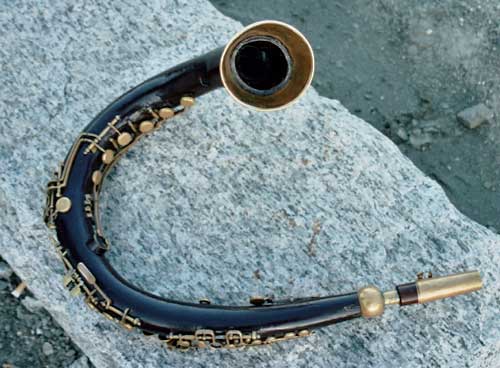
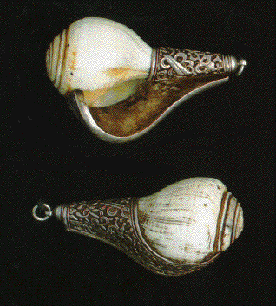
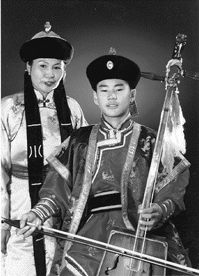
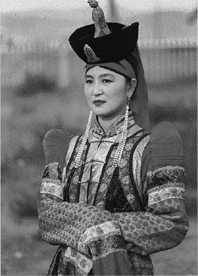
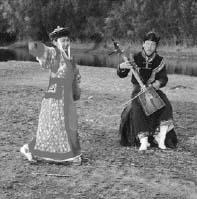
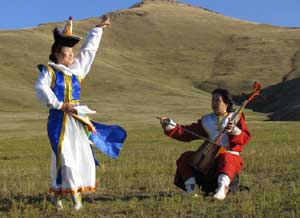


0 Comments:
Post a Comment
Subscribe to Post Comments [Atom]
<< Home